CHAPTER 10
T IS FOR TOXINS
IS YOUR MEMORY BEING POISONED?
Men who use aftershave, cologne, deodorants, or body washes to make themselves smell “sexy” are actively decreasing testosterone activity and thereby making themselves less manly.
JOSEPH PIZZORNO, ND, THE TOXIN SOLUTION
LEW: MOLD AND THE MIND
Lew, 67, had been a navy pilot and instructor for 40 years when he had to stop flying because he was unable to think through his flight plans. He and his wife were shocked when he made a mistake regarding some finances, potentially losing $100,000. He did not remember conversations; was unable to keep track of schedules, appointments, and everyday tasks; and forgot the names of people he’d recently met. Lew also had some difficulties with balance, and he felt tingling, numbness, and coldness in his fingers.

Lew and his wife following his treatment
His memory problems had begun approximately two years before he came to see Kabran Chapek, ND, at our clinic in Bellevue, Washington. By this point, his wife was afraid to leave him alone. Lew had seen several other doctors, but he felt “they were just throwing meds” at him before any tests were performed. Later, an MRI and EEG showed “age-related atrophy in brain volume and enlarged ventricles.” This was very disheartening to him: “I used to have an amazing memory, better than average.” His previous doctor had diagnosed him with dementia and gave him a prescription for Namenda, a dementia medication, which did not help.
Our laboratory testing revealed evidence that he had mold (mycotoxin) exposure. Lew and his wife found water damage in their home and had the affected area remediated. Through a cleansing program that included nutrition, supplements, meditation, and exercise (he hikes two to three miles every day with 30 pounds of rocks in a backpack), Lew’s memory began to improve. After five months on our program, he said, “I am so much better” —and his brain is better too. His wife said she noticed a huge improvement and was not afraid to leave him alone any longer.
Lew also had blood sugar issues, which improved over time as he cut out the “little chocolate doughnut” he had with his coffee every morning. That was a sacrifice for him, but as Dr. Chapek explained, “It’s your chocolate doughnut or your brain!”
Lew’s initial SPECT scan looked toxic (with a bumpy, scalloped pattern), which we’ve observed in many of the pilots we’ve scanned. Several months later, his follow-up SPECT showed remarkable improvement.
LEW’S BRIGHT MINDS RISK FACTORS AND INTERVENTIONS
BRIGHT MINDS |
LEW’S RISK FACTORS |
INTERVENTIONS |
Blood Flow |
Low blood flow on SPECT |
Exercise, diet, ginkgo biloba |
Retirement/Aging |
Age 67 |
|
Inflammation |
||
Genetics |
||
Head Trauma |
Dropped on his head while wrestling and injured his neck in high school; neck surgery 16 years later |
|
Toxins |
Mold exposure, flying planes, general anesthesia |
Stop mold exposure; treat for mold |
Mental Health |
||
Immunity/Infection Issues |
Low zinc |
Begin zinc supplements |
Neurohormone Deficiencies |
||
Diabesity |
High fasting blood sugar |
Giving up his little chocolate doughnut in the morning |
Sleep Issues |
LEW’S “BEFORE” BRAIN SPECT SCAN

Damage from exposure to mold
AFTER TREATMENT
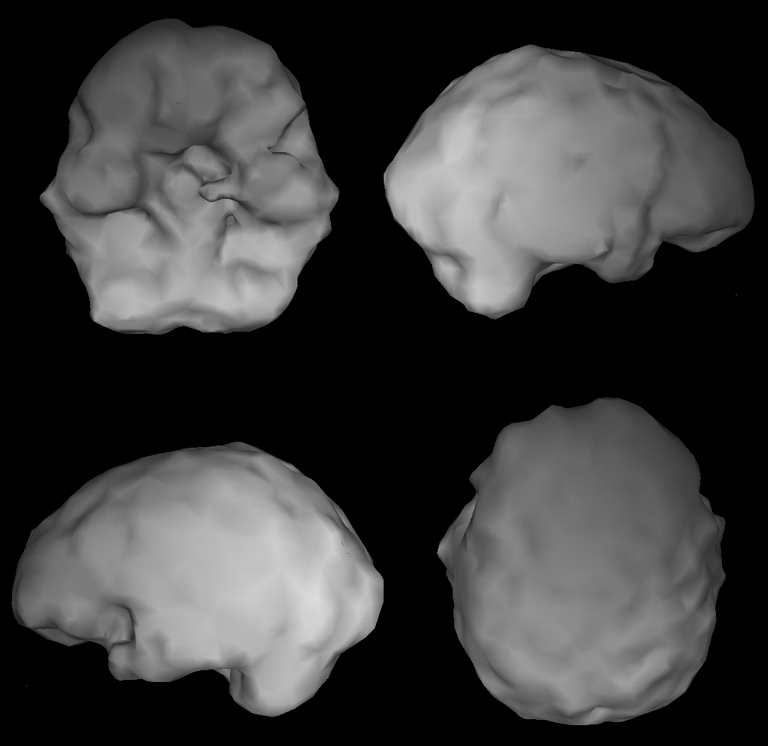
Overall improvement
LET’S PLAY 20 QUESTIONS (PLUS 2): WHICH OF THESE STATEMENTS APPLY TO YOU?
- Do you smoke or are you around secondhand smoke?
- Do you smoke marijuana?
- Do you use conventional cleaning products and inadvertently breathe their fumes?
- Have you been exposed to carbon monoxide?
- Do you travel on planes more than three to four times a year?
- Do you pump your own gas or breathe automobile exhaust?
- Do you live in an area with moderate to high air pollution?
- Have you lived or worked in a building that had mold in it?
- Do you come in contact with flame-resistant clothing or carpet, or with furnishings sprayed with chemicals to resist stains?
- Do you spray your garden, farm, or orchard with pesticides or live near an area with pesticides?[302]
- Do you paint indoors without excellent ventilation?
- Do you drink unfiltered water?
- Do you have more than four glasses of alcohol a week?
- Do you regularly eat processed or fast foods?
- Do you regularly eat conventionally raised produce, meat, or dairy, or farm-raised fish?
- Do you eat large (i.e., mercury-contaminated) fish, such as swordfish?
- Do you regularly eat nonorganic fruits and vegetables?
- Do you consume foods with artificial colors or sweeteners, such as diet sodas, or add artificial sweeteners, such as aspartame (NutraSweet), sucralose (Splenda), or saccharin (Sweet’N Low) to your beverages or food?
- Do you use more than two health and/or beauty products per day without reading and understanding their labels?
- Does your house contain lead pipes or copper plumbing soldered with lead?
- Do you have mercury amalgam fillings? How many?
- Do you work in a job such as firefighting, painting, welding, or working in a shipyard, where you are exposed to environmental toxins?
If you answered yes to more than two questions, this chapter could be very important to the rest of your life.
THE IMPACT OF TOXINS ON YOUR BRAIN AND MEMORY
As a classically trained psychiatrist, I received virtually no training on the impact of toxins on the brain or as a cause of brain fog, memory problems, anxiety disorders, depression, ADHD, autism, temper outbursts, psychotic behavior, obesity, and diabetes. It wasn’t until I started looking at the brain that I started to realize the connection between toxins and health problems.
Research now shows that many people with allergies, autoimmune diseases, neurodegenerative diseases, diabetes, and cancers have one thing in common: exposure to environmental toxins. Our bodies have systems in place to get rid of toxins (through the gut, liver, kidneys, and skin), but when our detoxification systems are overwhelmed, we experience brain fog, fatigue, and life-threatening illnesses.
Toxins in any form damage the brain and increase the risk of memory problems and dementia. On SPECT scans, toxins show a pattern I call “scalloping” —overall low activity that leaves the brain looking irregular and bumpy.
“I don’t do that anymore”
About 10 years ago, I gave a lecture to a thousand people at Skyline Church in San Diego. The next year I was invited back. As often happens when I speak at a place for the second time, a number of people approached me with their SPECT scans because my first lecture had motivated them to come to one of our clinics to have their own brains evaluated. On this occasion, a 35-year-old man, Scott, came up to me to show me his scan, which looked awful. The Swiss cheese appearance indicated seriously low overall activity, the same pattern we often see in our drug or alcohol abusers. As I looked at the scan, Scott said, “You think I am a drug addict, don’t you?”
“The thought had crossed my mind,” I replied.
“I have never used drugs,” Scott said, “and I don’t drink. But before I came to your clinic, I used to paint cars in my garage without much ventilation. I don’t do that anymore.”
“That is the sign of intelligent life,” I replied. “New information caused you to change your behavior.”
He went on to tell me that he and his wife had been in marital therapy for several years without any benefit. After his visit to our clinic in Costa Mesa, he started to live a brain-healthy life, taking a multivitamin, fish oil, and the other brain-healthy supplements we recommended. He also ate better and exercised regularly. The difference, he said, had been life changing. After his brain got better, he was a better husband. I wonder how many marriages are suffering because one partner has a brain problem that no one is aware of. How do you do marital therapy with the brain on the next page? It won’t work until you help heal that brain.
SCOTT’S “BEFORE” BRAIN SPECT SCAN
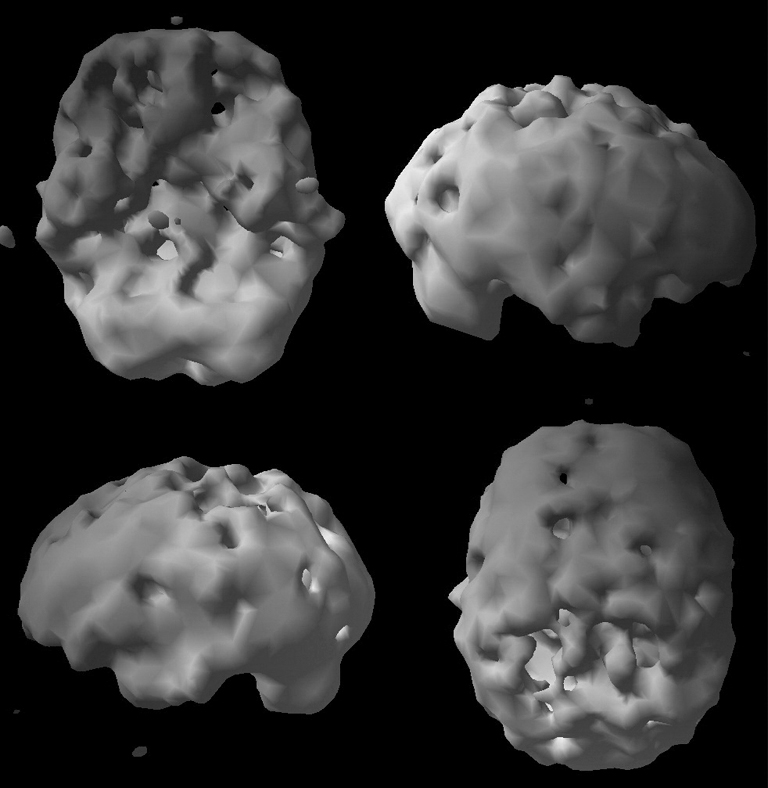
Note the overall bumpiness or “scalloping” associated with toxic exposure
Toxins: the poisoning of the brain
Common toxins associated with memory loss can be absorbed through the skin (say, when you rub in a cream), ingested when you eat or drink, or inhaled as you breathe. Check these lists to see which toxic substances you may have been exposed to, either now or in the past.
TOXINS THAT CAN BE INGESTED OR ABSORBED
- Polluted or tainted water (including lead and arsenic)
- BPA (bisphenol A, found in plastics, food and drink containers, dental sealants, and the coating of cash register receipts)
- PCBs (see “Gone —But Not Forgotten” on page 146)
- Heavy metals, such as
- mercury: in “silver” dental fillings (which are 50 percent mercury) and contaminated fish. (The Environmental Protection Agency recommends pregnant women eat fish no more than two or three times a week; limit the consumption of certain varieties, such as grouper and albacore tuna; and avoid the big seven: king mackerel, marlin, orange roughy, swordfish, shark, bigeye tuna, and tilefish from the Gulf of Mexico.)[303]
- lead: in paint, pipes, aviation fuel, and lipstick (see page 149).
- cadmium: in cigarettes, soils treated with synthetic fertilizers, and industrial and hazardous waste sites. Cadmium is highly toxic and accumulates in the liver and kidneys. It is linked to osteoporosis, heart disease, cancer, and diabetes. Once it is in your body, it takes 16 years to get rid of just half of it!
- Excessive alcohol
- Marijuana
- Many medications, such as benzodiazepines (for anxiety or insomnia) or narcotic pain medications
- Chemotherapy
- General anesthesia in some patients
- Silicone breast implants that have leaked
- MSG
- Artificial food dyes, preservatives, and sweeteners
- Herbicides such as glyphosate (the active ingredient in Roundup weed killer, with residue present in genetically modified crops) disrupt the body’s endocrine or hormonal system, affecting both testosterone and estrogen.[304] Herbicides may also damage DNA, making cells age faster and increasing their susceptibility to cancer.
- Pesticides, such as organochlorines and organophosphates (neurotoxins), stimulate enzymes that turn calories into fat, which is where toxins are stored. In one study, people in the top 5 percent of exposure to the organochlorine pesticide DDT had a 650 percent increase in dementia.[305]
- Apples sprayed with diphenylamine, which makes them shiny and slows discoloration but breaks down into cancer-causing nitrosamines, associated with Parkinson’s and Alzheimer’s[306]
- Foods manufactured with plastic equipment, leaking plasticizers
- Health and beauty products absorbed through the skin[307]
DISTURBING FACT: One of the most effective ways for a woman to decrease her toxic load is through breastfeeding, which decreases the risk of breast cancer. Unfortunately, the baby gets the brunt of it.
TOXINS THAT CAN BE INHALED
- Air pollution
- Cigarette smoke, secondhand smoke, marijuana smoke
- Automobile exhaust
- Gasoline fumes
- Toxins in the air near high-traffic areas (air pollution, auto exhaust)[308]
- Cleaning chemicals
- Welding,[309] soldering fumes
- Fire retardant fumes
- Carbon monoxide
- Asbestos
- Aviation fumes
- Fire toxins inhaled by firefighters during fires
- Fireplace fumes
- Paint and solvent fumes
- Pesticide or herbicide residues near farms, also backyard applications
- Mold

Gone —but Not Forgotten

Toxins poison your brain in 10 ways, both directly and indirectly.[312] They
- Harm enzyme systems, which disrupts many biological processes, including the production of energy and the ability to fight free radicals.
- Lower cerebral blood flow, which makes it harder to think and make good decisions.
- Damage organs, including those in the digestive tract, the liver, kidneys, and brain. This damage reduces the body’s ability to detoxify and get rid of the toxins.
- Damage DNA, which can accelerate aging.
- Change gene expression, which not only hurts affected individuals, but can also hurt their children, grandchildren, and even great-grandchildren.
- Damage cell membranes and communication between cells.
- Disrupt, suppress, or block hormones, causing serious imbalances.
- Impair the immune system, increasing the risk of autoimmune disorders and cancer.
- Disrupt the intestinal microbiome, resulting in leaky gut and accompanying problems.
- Increase the risk of diabetes and obesity as the internal toxic load rises. Toxins are also called “diabesogens” and “obesogens” because they can make us diabetic and obese.
Because toxins can affect so many parts of the body, they are associated with a wide range of symptoms. Those that are more directly associated with the brain include poor memory and concentration, word confusion, mood issues, headaches, vertigo, and cravings. Other problems range from abdominal pain, diarrhea, smelly stools, bad breath, low appetite, and weight issues to skin rashes, fatigue and weakness, aches and muscle cramps, numbness and tingling, tremors, sweats, and problems with temperature regulation —and there are more.
Here are some of the most common toxic issues we see at Amen Clinics.
Health and beauty aids: the price of looking good
The average American woman uses about 12 personal care and cosmetic products daily; the average man, about six.[313] The chemicals in these products are easily absorbed into your skin and are transported to every organ in your body. That means you may be working hard to look good on the outside but poisoning yourself on the inside in the process. In 2016, Johnson & Johnson was ordered to pay $72 million to the family of a woman whose death from ovarian cancer was associated with the daily use of Johnson’s Baby Powder, among other company products.[314]
The Environmental Working Group’s Skin Deep database (http://www.ewg.org/skindeep/) contains information on many products with toxic ingredients and provides healthier options. Below is a chart of chemicals commonly found in personal care products, along with descriptions of the havoc they wreak, from a book I highly recommend —The Toxin Solution by Joseph Pizzorno, ND, a founder of Bastyr University.
COMMON CHEMICALS FOUND IN HEALTH AND BEAUTY AIDS
CHEMICAL |
PURPOSE |
TOXICITY |
Acrylates |
Artificial nails |
Neurotoxins[315] |
Aluminum |
Antiperspirant |
Potential connection to Alzheimer’s disease[316] |
Formaldehyde |
Shampoos, nail polish, hair gel, nail and eyelash glue, body wash, color cosmetics |
|
Fragrance |
Shampoos, liquid baby soap, nail polish, glues, hair smoothing, body wash, color cosmetics |
Cancer, endocrine disruption, allergic reactions |
Oxybenzone |
Sunscreen |
Endocrine disruption, lowers sperm count, skin allergies |
Parabens |
Preservative, fragrance in cosmetics (eye shadow, foundation, mascara), shampoos, conditioners, lotions, facial/body cleansers |
Endocrine issues, breast cancer,[319] developmental problems in kids, reproductive problems, allergies |
Phthalates (banned in Europe) |
Fragrances in cosmetics Also used in plasticizers (plastic wrap, packaging) |
Endocrine disruption;[320] lower IQ;[321] decreases BDNF in males,[322] which helps neurons grow and connect |
Polyethylene glycols (PEGs) |
Create suds in shampoos, bubble baths, liquid soap |
|
Triclosan |
Antimicrobial cleanser, toothpaste |
|
Lead |
Lipstick (kiss of death) |
Neurotoxin, damage to hippocampus and prefrontal cortex[327] |
See also: The Toxin Solution by Joseph Pizzorno, ND |
||
Lead: the kiss of death
Lead exposure is related to learning problems in children, lower IQ, speech problems, cancer, cardiovascular problems, arthritis, seizures, headaches, anemia, kidney disease, a metallic taste, and death from all causes. The “safe” level of lead, measured in the bloodstream, used to be less than 60 mcg/dL (micrograms per deciliter), according to the US government. That number has since been lowered to under 10 mcg/dL, and in July 2012, the Centers for Disease Control and Prevention determined that lead in the range of 5 to 10 mcg/dL is particularly problematic for children. Many scientists believe lead is unsafe for humans at any level.
To protect Americans from lead poisoning, the government had the metal removed from gasoline and paint, but it was left in small plane aviation fuel. When we scanned 100 pilots at Amen Clinics, we saw evidence of significant brain toxicity in two-thirds of them. Could it be caused by lead and other toxins they are exposed to when they fly? As for paint problems, any house painted white before 1978 has high levels of lead, which can pose a problem when the paint chips or peels. And houses built or remodeled before 1986 have lead in the pipe solder.
No regulation has required that lead be removed from one of the most widely used cosmetics: lipstick. When lipstick was tested in 30 national brands, lead was found in 60 percent of them.[328] In 2013, researchers at the University of California, Berkeley, found lead in 24 of 32 lip products tested. A number of the products also had high levels of eight other metals, such as cadmium and chromium.[329] To avoid buying and ingesting lead-contaminated lip products, know your lipstick brands and go to www.safecosmetics.org to learn more.
Smoking
When you look at the studies that are not sponsored by the tobacco industry, you can see that smoking clearly increases the risk of dementia —that is, if it doesn’t kill you first.[330] Smoking has serious negative health effects. Cigarettes, including tobacco, marijuana, and electronic nicotine and caffeine delivery systems, are efficient ways to inhale into your lungs a host of fine and ultrafine toxic junk that then gets to your brain. Does size matter? Yes! The smaller the particle you inhale, the greater its ability to cause inflammatory reactions and damage your brain.
In 2014, the World Health Organization concluded that tobacco use and exposure to secondhand smoke increased incidence rates for all types of dementia, including Alzheimer’s.[331] Smoking is thought to cause dementia in the same way it contributes to vascular diseases: by bombarding the brain with hundreds of different toxins, increasing homocysteine (high levels trigger inflammation), accelerating blood vessel damage (which deprives your brain of oxygen and nutrients), and increasing inflammation and the particulate toxic load in your brain.
Alcohol and marijuana
In recent years, these two hugely popular drugs have become tricky issues. I have a different perspective from most, having worked as an ambulance driver, in emergency rooms, and as a psychiatrist for the past 35 years. I have seen how alcohol devastates families and examined thousands of brain SPECT scans of “moderate” drinkers and pot smokers. Overall, I have seen much more harm than good from these substances.
We’ve all heard the reports that alcohol is a health food and marijuana is harmless. Indeed, large-scale studies seem to indicate that mild to moderate alcohol use may be good for your heart and mind.[332] Yet the results from a 30-year study of 550 men and women that was published in the BMJ (formerly the British Medical Journal) suggest that even moderate drinking —one or two glasses of wine a day —leads to atrophy in the hippocampus.[333]
This same study showed no protective effect from drinking one to seven small glasses of wine per week, so you shouldn’t feel you have to drink to improve your brain. In a 43-year follow-up study of more than 12,000 people,[334] nondrinkers and light drinkers had a comparable dementia risk, while heavy and very heavy drinkers had an increased risk. Drinking more hard liquor (gin, rum, vodka, tequila, whiskey, brandy) increased the odds of dementia, whereas imbibing wine in moderate amounts is associated with a lower risk (although those who drink large amounts of wine are also at increased risk). Relative to nondrinkers and light drinkers, moderate to heavy drinkers have a 57 percent higher risk of dementia —and they develop it earlier.
A study at Johns Hopkins found that people who drink every day have smaller brains.[335] In addition, alcohol is related to seven different types of cancer, including those involving the mouth, throat, esophagus, liver, colon, rectum, and breast.[336] Why do nurses rub alcohol on your skin before they give you a shot or insert an IV needle? To kill bacteria. Why is alcohol used to preserve dead specimens? To kill all the cells and tissues in the specimens. This should make you wonder what alcohol is doing to your gut.
Alcohol can decrease judgment and decision-making skills, increase cravings, and make you less coordinated. Excessive alcohol is related to high blood pressure, stroke, irregular heartbeat, heart disease, and a weakening of the immune system. To detoxify alcohol, your liver uses glutathione and other essential antioxidants. This can make you more vulnerable to other toxins or weaken your liver function and immunity to infection. Alcohol is associated with a fatty liver and damaged neurons, and it lowers blood flow to the cerebellum, an amazing part of the brain that is associated with physical and thought coordination. Alcohol interferes with the absorption of vitamin B1 and is a common cause of nerve pain. Excessive drinking is listed as the fourth leading cause of preventable death. In the United States, there are about 30 million children of alcoholics, many of whom suffer from post-traumatic stress disorder as a result of growing up in an unpredictable, abusive alcoholic home. Excessive alcohol use is a major cause of divorce, incarceration, and financial problems. If you want a better brain, less is more. For people who want to drink, I recommend no more than two to four servings a week.
BRAIN SPECT SCAN OF HEAVY ALCOHOL USE
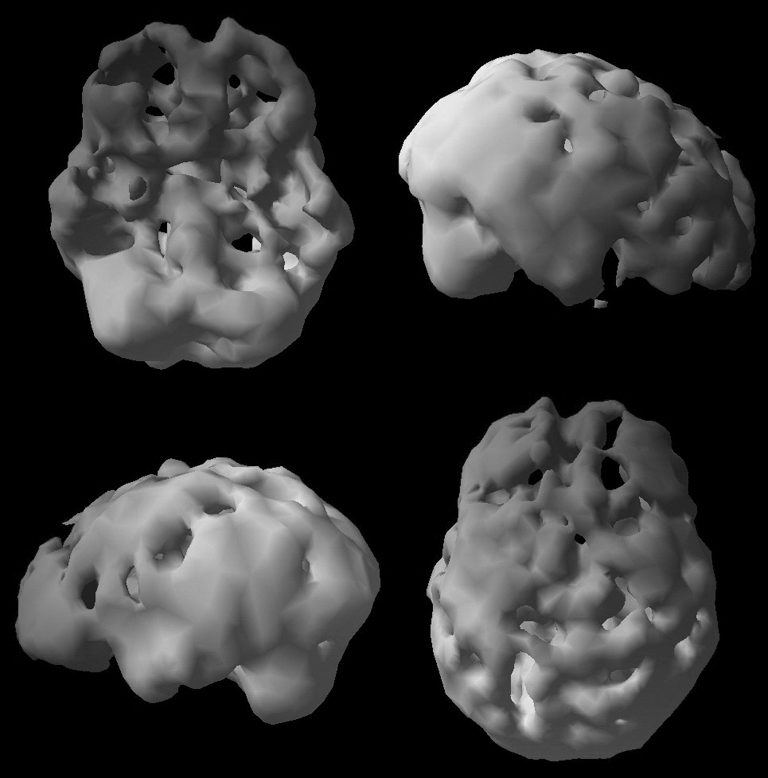
I’m also not a fan of recreational marijuana use. In 2016, we published the largest brain imaging study to date on marijuana users showing overall decreased blood flow in 982 of them compared to 92 healthy nonusers.[337] Blood flow was decreased the most in the right hippocampus, an area commonly involved with Alzheimer’s disease and memory loss of all types.
Many years ago, I was on Michael Savage’s radio show in San Francisco. We were discussing my observations on marijuana and the brain. Michael predicted that many recreational users would call in to the show wanting to challenge me. I told him that almost everyone calling would be concerned about memory issues. We were both right.
Here is an image of a young daily marijuana user. If the drug does this when you are young, imagine the issues it can cause as you age!
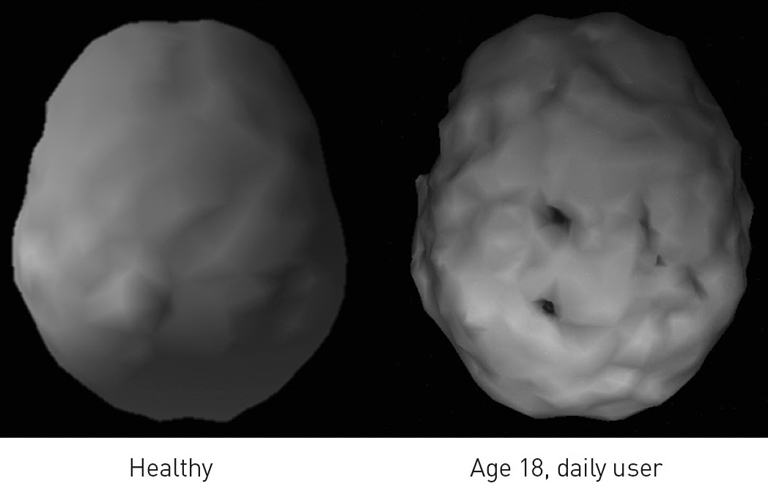
The impact of mold
One of the early lessons from our brain imaging work was that many substances are toxic to brain function, and one that is particularly toxic is mold. Here’s just one example: In 2003, after reading my book Change Your Brain, Change Your Life, Bulletproof 360 CEO Dave Asprey got a brain SPECT scan. It changed everything for him. He was struggling with focus and memory and barely able to pass his classes at Wharton. It turned out that Dave had been exposed to toxic mold in his home. After he underwent healing protocols, his life dramatically improved, and he went on to produce Moldy: The Toxic Mold Movie (watch it online at https://moldymovie.com).
A young man I’ll call George came to see us at Amen Clinics complaining of sleep disturbance, anxiety, memory problems, and brain fog. After taking a careful history, we learned that George’s symptoms started when he moved back home from college into his parents’ basement apartment. The whole family seemed to have forgotten that the basement had flooded on several occasions. Mold diagnostic testing revealed George had high levels of mold toxins in his body.
In such cases, the first step is always to remove the affected person from the moldy environment and then to begin treatment —consisting of binding agents and other medications, such as antifungals, as well as metabolic support supplements. For information on mold testing and cleanup, visit https://www.epa.gov/mold and https://www.cdc.gov/mold/. I recommend that you consult an integrative medicine doctor if you suspect a mold exposure problem. George improved with proper treatment and remediation of the mold problem. He did not need psychiatric medications; he simply needed the correct diagnosis and appropriate treatment. What would have been the outcome for him without a proper diagnosis? He almost certainly would have been diagnosed with a mental illness and treated (unsuccessfully) with psychiatric medications.
General anesthesia: cause for concern
I first became aware of the potentially toxic risk of general anesthesia[338] when a patient of mine called me in tears after knee surgery. She said she was having difficulty thinking and remembering and thought she was getting Alzheimer’s disease. Since I had done a prior SPECT scan on her, I rescanned her and found that her brain looked toxic and was dramatically worse in her frontal and temporal lobes, which are both involved in memory. It was clear that something bad had happened to her brain since the first scan was taken. She improved after following the BRIGHT MINDS approach to rescue her memory.
Current research on general anesthesia is mixed, with some studies showing no lasting negative effects and some showing toxic effects, but two recent studies stand out: Children who had undergone general anesthesia before the age of four had lower IQ, diminished language comprehension, and decreased gray matter in the back of their brains.[339] That is very concerning. Also, a before-and-after SPECT study of patients who underwent coronary artery bypass surgery showed that 68 percent had diminished blood flow, which was linked to decreased verbal and visual memory six months later.[340] I recommend local or spinal anesthesia whenever possible. If it is not possible, make sure to do everything else right for your brain.
High risks for first responders
Firefighters, police officers, and emergency medical technicians —aka first responders —are the everyday heroes in our society. These brave men and women are involved in dangerous professions that pose many health risks and can have a long-lasting negative impact on their brain function. They are exposed to environmental toxins such as carbon monoxide, benzene, asbestos, and diesel exhaust; head injuries; and emotional trauma. (After taking one dead baby from a burning car or seeing someone who has shot himself in the head, a first responder isn’t likely ever to be quite the same again —and these professionals experience many emotional traumas over their careers.) The need for early brain health intervention programs among these professions is critical because studies show an elevated risk of post-traumatic stress disorder and suicide in first responders.[341]
Adam: the trauma of fighting fires
Adam, 33, a firefighter for six years, came to see me for depression, insomnia, and poor concentration. He was struggling in his relationship with his wife and felt distant from his two small children. He cried as he related the many traumas he had seen, especially the first one, when he arrived at a home where a teenage boy had shot himself at point-blank range. He said he could still hear the boy’s mother screaming. On other occasions while on the job, Adam also suffered two concussions and a bout of smoke inhalation while battling a Southern California fire.
His lab tests showed low testosterone and vitamin D levels. His scan showed overall low activity in his brain. Adam was one of the most compliant and motivated patients I have ever helped. Within six months his depression had lifted, his brain was better, and he had more skills to deal with the inevitable emotional trauma in his profession.
FIREFIGHTER ADAM’S “BEFORE” BRAIN SPECT SCAN
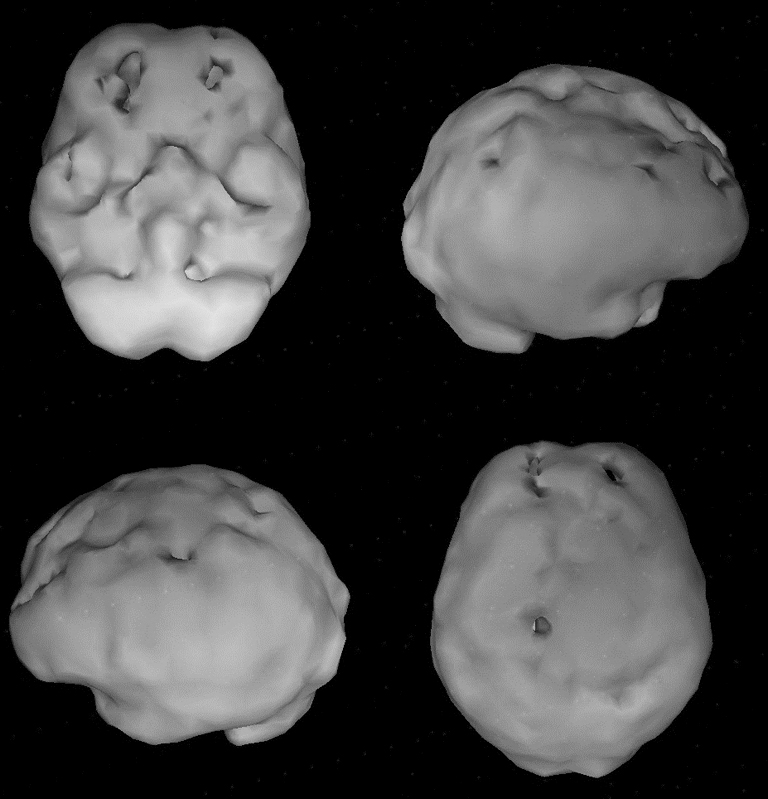
Overall low activity
ADAM’S BRIGHT MINDS RISK FACTORS AND INTERVENTIONS
BRIGHT MINDS |
ADAM’S RISK FACTORS |
INTERVENTIONS |
Blood Flow |
Low blood flow on SPECT |
Exercise, diet, ginkgo biloba |
Retirement/Aging |
||
Inflammation |
||
Genetics |
||
Head Trauma |
Two concussions at work |
Nutraceuticals and HBOT |
Toxins |
Multiple toxins from firefighting |
Strengthen all detox systems |
Mental Health |
Depression, emotional trauma, stressful job |
Nutraceuticals and psychotherapy |
Immunity/Infection Issues |
Low vitamin D |
Vitamin D3 supplements |
Neurohormone Deficiencies |
Low testosterone |
Limited sugar, DHEA supplementation |
Diabesity |
||
Sleep Issues |
Insomnia after accident |
Sleep strategies |
Other toxins
At Amen Clinics, we have also seen many patients with a history of cancer chemotherapy. Chemotherapy kills cancer cells, but unfortunately it can kill healthy brain cells too.[342] Likewise, excessive exposure to heavy metals, including arsenic, lead, mercury, iron, aluminum, and bismuth (found in Pepto-Bismol —but you have to take a lot of it) can cause significant memory problems. Screening tests can be very helpful to discover what your heavy metal load is. If it is elevated, I suggest you consult an integrative medicine doctor.

Should We Be Concerned About GMOs?


CHECKUP FOR TOXINS ISSUES
Your detoxification organs, including your gut, liver, kidneys, and skin, need to be healthy to do their job. Your liver, for instance, filters blood to identify and hold toxins. Its enzyme systems then break them down and produce bile to excrete them. Your kidneys filter all of your blood a remarkable 60 times per day. However, kidney function decreases by 50 percent from age 20 to age 85,[345] so they need your support!
For a gut checkup, see chapter 7. For information on how to protect your other organs, keep reading.
If you have limited resources, skip the expensive lab tests and spend your money on high-quality detoxifying food. |
Lab tests
Your liver has finite toxin-processing capacity; therefore, it is highly vulnerable to toxic overload. The following tests can help determine how strained it is.
LIVER FUNCTION
- ALT (SGPT): Normal range: 7 to 56 units per liter (U/L)
- AST (SGOT): Normal range: 5 to 40 U/L
- Bilirubin: Normal range: 0.2 to 1.2 mg/dL
- Zinc: Normal range: 60 to 110 mcg/dL (low zinc will limit detoxification in the liver)
If your liver function tests are high, cut back on your intake of sugar, simple carbohydrates, and alcohol. Also, you and your doctor might consider whether hepatitis or medications that raise liver enzymes, such as acetaminophen (Tylenol), could be affecting your liver’s function.
KIDNEY FUNCTION
- BUN: Normal range: 7 to 20 mg/dL
- Creatinine: Normal range: 0.5 to 1.2 mg/dL
SKIN
- Check for rashes, acne, and rosacea. All are clues to detoxification problems.
TESTING FOR MOLD
- TGF beta-1: This blood test measures a protein found throughout the body that plays a role in immune system function and is often high following mold exposure (also called mycotoxin exposure). Certain infections, such as Lyme disease (see chapter 12), may also increase levels of this protein. The normal level is below 2,380; 0 is optimal. Mold exposure can raise this to more than 15,000.
- Real Time Labs mycotoxin test (http://www.realtimelab.com/home): Real Time Labs tests human and environmental samples for mold.
TESTING FOR HEAVY METALS
- Hair sample and urinary challenge tests are easy to access through doctors of integrative medicine.

PRESCRIPTION TO REDUCE YOUR TOXINS RISK
The Strategies
You can reduce your toxic load with two simple strategies: (1) limit your exposure to toxins, and (2) strengthen your detoxification systems, especially your gut, liver, kidneys, and skin.
- 1. Limit your exposure to toxins.
- Quit smoking. Try hypnosis, nicotine patches, or bupropion to kick this habit.
- Address drug and/or alcohol abuse. Look for the underlying causes of why you use, such as untreated anxiety or depression. I recommend eliminating marijuana completely.
- Slowly replace “silver” dental fillings. Opt for ceramic fillings rather than amalgams when possible. I suggest removal of amalgam fillings just as soon as feasible, but not all at once because of the risk of releasing toxins into the bloodstream. Removing just one or two at each dental session is best.
- Reduce your consumption of toxin-contaminated foods.
- Buy organic (and always wash your food). One study found that concentrations of selected pesticides detected in urine samples decreased by 95 percent when a family switched to organic food for two weeks.[346] In another study, the neurotoxic pesticide levels of children who ate conventionally grown foods were nine times higher than those who ate organic.[347] For more information on which foods have the highest and lowest pesticide loads, check out the Environmental Working Group (EWG) website (www.ewg.org).
- Always read and understand food labels. If you do not know what is in something, don’t eat it or put it on your body. Avoid the following chemicals, including additives and preservatives:
- Potassium bromate —carcinogen
- BHA, BHT —linked to tumors
- Sodium benzoate —may damage DNA
- Sodium nitrate —linked to cancer
- Tartrazine dye (makes cheese yellow) —linked to asthma
- Monosodium glutamate (MSG and related ingredients, including glutamic acid, hydrolyzed protein, autolyzed protein, autolyzed yeast extract, and textured protein) —linked to seizures and heart issues
- Red dye #40 —possible allergen and carcinogen
- Artificial sweeteners —aspartame (blue packets) and saccharin (pink packets) are both linked to obesity, diabetes, and cancer.[348] Sucralose (yellow packets) is metabolized like PCBs and dioxins, both of which have the potential of causing direct toxic effects. Sucralose may induce glucose intolerance by disrupting the microbiome.[349]
- Ignore the word natural on labels. When used there, it is meaningless.
- Limit or eliminate conventionally raised produce (treated with pesticides and herbicides), dairy (affected by hormones and antibiotics), grain-fed meats, and grain-fed farmed fish.
- Avoid aluminum and Teflon cookware. Teflon may release toxic fumes when overheated.
- Buy and store foods in glass jars when possible. Plastic containers may contain phthalates (a plasticizer) and BPAs. Never reheat foods in plastic containers.
- Avoid processed meats such as bacon and smoked turkey. They contain nitrosamines, which cause the liver to produce fats that are toxic to the brain.
- Limit alcohol consumption to no more than two to four servings a week; choose wine and beer over aged liquors.
- Add fiber and fiber-rich foods, which bind to toxins and help your gastrointestinal system get rid of them. In the past, humans ate 100 to 150 grams of fiber a day. Americans now eat an average of about 15 grams.[350] Women should consume at least 21 grams; men, 30 grams.
- Drink eight to ten glasses of clean water a day to stay hydrated. Water helps flush toxins from your kidneys. Filter your water with charcoal or reverse osmosis. Check the purity of your local water supply with this EPA link: https://ofmpub.epa.gov/apex/safewater/f?p=136:102.
- Do a food detox. For two weeks, eliminate the following:
- Processed foods
- Glutens, which can increase gut permeability, even in people who are not sensitive to them (found in flour, triticale, triticum, semolina, durum, Kamut, wheat, rye, and barley)
- Dairy
- Nonorganic beef and chicken to avoid hormones, antibiotics, and arsenic
- Farmed fish
- The “Dirty Dozen” produce items, designated by the EWG (see https://www.ewg.org/foodnews/summary.php)
- Soy (high levels of arsenic, cadmium; 96 percent of US soy is genetically modified)
- Artificial sweeteners
- Alcohol and recreational drugs
- Water that has not been purified or proven to be clean
- Breathe clean air.
- Check your home for mold and eliminate it whether or not you are symptomatic.
- Refrain from having wood fires in fireplaces since they release toxic compounds.
- Change the filters on your heating and cooling systems regularly.
- Decrease your use of unsafe health and beauty aids.
- Do a bathroom cleanse. Download the “Think Dirty” app (www.thinkdirtyapp.com) and then scan all the products in your bathroom. Think Dirty rates products on a scale of 1 to 10 (10 = the most toxic). If you care about your health, throw out toxic products. When I first downloaded this app, I threw out more than 70 percent of the products in my bathroom.
- Use natural products without fragrance that are low in chemicals and free of phthalates. This can really make a difference: 100 teenage girls who avoided these chemicals for just three days had significantly lower levels of toxins in their urine.[351] Natural products may be more expensive in the short run, but they will be cheaper in the long run as you will spend less money on doctor appointments and medicine.
- Clean the house thoroughly.
- Use carbon monoxide alarms and nonradioactive smoke alarms.
- Use fragrance-free natural household cleansers.
- Clean, dust, and vacuum regularly.
- Do not use Scotchgard or any other chemicals that prevent stains on anything in the home.
- Periodically check for black mold in any potentially wet area of your home.
- Limit the use of volatile organic compounds (VOCs), often found in cleaning products and air fresheners, by replacing them with VOC-free cleaning products, no- or low-VOC bedding materials made from natural products, low-VOC paints, and throw rugs instead of new carpeting. For more information on the health effects of common household products, see the Household Products Database from the National Institutes of Health/National Library of Medicine at https://hpd.nlm.nih.gov/products.htm.
- 2. Strengthen Your Detoxification Systems
- Support your gut. (See chapter 7.)
- Support your liver and kidneys with the nutraceuticals and food recommendations listed on the following pages.
- Support your skin. Your skin is the largest organ of your body.[352] The state of its health is a reflection of the health of your brain.
- Work up a sweat with exercise. It is one of the best natural ways to cleanse your system. The concentration of most toxins —including arsenic, cadmium, lead, and mercury —is 2 to 10 times higher in sweat than in blood, which indicates that sweating is an effective detoxification process.[353] Boosting sweat with exercise significantly increases glutathione production, one of the most important detoxification nutrients; protects against PCB exposure; helps eliminate phthalates and bisphenol A; and helps keep your skin healthy.[354]
- Take a sauna. Saunas have been found to lower toxins in firefighters, which can be an important intervention for this at-risk group.[355] In a follow-up study over 20 years, researchers from Finland found an inverse relationship between sauna bathing and serious memory problems. Compared with men who had one sauna bathing session per week, those who had two to three sessions or four to seven saunas were, respectively, 22 percent or 66 percent less likely to have dementia![356] In other research, those who had frequent sauna baths also had a lower incidence of sudden cardiac death and death from all causes.[357] Saunas have also been found to help depression in cancer patients; increase feel-good endorphins, testosterone, and growth hormone; lower the stress hormone cortisol; and lower blood sugar.[358] According to the research, the goal should be to sweat profusely for 20 to 30 minutes.[359]
- Take nutraceuticals and eat foods that are good for your skin. Refer to the lists of nutraceuticals and foods below and on the following pages.
The Nutraceuticals
TO SUPPORT YOUR LIVER
- NAC (N-acetylcysteine): 600 mg twice a day. NAC raises blood, liver, cellular, and mitochondrial levels of cysteine and the super-antioxidant glutathione. NAC has also been shown to help decrease the toxicity of chemotherapeutic drugs used to treat cancer and of antibiotics used against infections.[360]
- Vitamin C: 1,000 mg twice a day
- Selenium: 200 micrograms (mcg) a day
- Zinc: 20 to 30 mg a day
- Folate (MTHF, methylfolate): 400 mcg a day
- Vitamin B12 (methyl cobalamin): 500 mcg a day
- Curcumin (in a bioavailable form like Longvida): 300 mg twice a day for excellent liver protection; increases bile excretion and decreases cholesterol
- Artichoke extract: significantly increases bile excretion from the liver for two to three hours[361]
TO SUPPORT YOUR KIDNEYS
- Magnesium glycinate, citrate, or malate: 200 mg twice a day
- Curcumin: 300 mg twice a day
- Ginkgo biloba extract: 60 mg twice a day; increases blood flow to brain and kidneys[362] and helps protect against glyphosates[363]
- Fiber: seven grams (women) or ten grams (men) three times a day combined in food and supplements
- NAC (N-acetylcysteine): 600 mg twice a day
- Omega-3 fatty acids: 1.4 grams (or more) of a combination of EPA and DHA in about a 60/40 ratio per day
TO SUPPORT YOUR SKIN
- Vitamin D3: 2,000 IUs a day or more, depending on your level
- Vitamin E: 60 mg of mixed tocopherols a day
- Omega-3 fatty acids: 1.4 grams (or more) a day of a combination of EPA and DHA in about a 60/40 ratio
- CoQ10: 100 mg a day
- Alpha-lipoic acid: 300 to 600 mg a day
- Grapeseed extract: 100 to 300 mg a day
- EGCG: 600 mg a day
- Curcumin: 500 mg a day
- Selenium: 150 micrograms (mcg) a day
- Zinc: 25 mg a day
- Astaxanthin: 4 to 12 mg a day
The Foods
CONSIDER ADDING:
TO NOURISH YOUR LIVER
- Green leafy vegetables for folate, an essential detoxification nutrient
- Protein-rich foods, including eggs
- Brassicas: any color cabbage, brussels sprouts, cauliflower, broccoli, kale for detox; consuming more brassicas also has been found to lower breast cancer risk.[364]
- Oranges and tangerines: vitamin C/d-limonene, many beneficial flavonoids
- Berries: wide diversity of flavonoids
- Sunflower and sesame seeds: high in cysteine
- Caraway and dill seeds: d-limonene[365]
TO NOURISH YOUR KIDNEYS
- Water
- Spices to support detoxification: clove, rosemary, turmeric[366]
- Nuts and seeds: cashews, almonds, and pumpkin seeds for magnesium
- Green leafy vegetables
- Citrus fruits, except grapefruit
- Beet juice for circulation and endurance
- Ginger for its anti-inflammatory properties
- Blueberries (increase filtration rate in kidneys), raspberries, strawberries, blackberries
- Garlic
- Sugar-free chocolate: increases blood flow
TO NOURISH YOUR SKIN
- Water
- Green tea
- Colorful fruits and vegetables for antioxidants: especially organic berries, kiwifruit, oranges, tangerines, pomegranates, broccoli, and peppers
- Avocados
- Olive oil
- Almonds, walnuts, sunflower seeds
- Wild salmon
- Sugar-free chocolate
AVOID (OR LIMIT):
FOODS AND MEDICATIONS THAT INHIBIT LIVER DETOXIFICATION
- Processed meats such as bacon and smoked turkey, that contain nitrosamines, which cause the liver to produce fats that are toxic to the brain
- Grapefruit (juice may interfere with medications)
- Capsaicin from red chili peppers
- Conventionally raised produce; dairy; grain-fed meats; and farmed fish
- Medications such as antihistamines, acetaminophen, stomach acid blockers, some antidepressants (such as fluoxetine), and anti-anxiety medications (such as diazepam). Be sure to consult with your doctor before discontinuing any medication.
Note: If you do a liver detox, keep in mind that it is common to feel worse for a week or so while your body unloads toxins. These reactions include feeling tired, achy, irritable, and/or dizzy, and having skin rashes, smellier urine or stools, a stuffy nose, or headaches. Be patient: Those symptoms will likely subside quickly.
FOODS THAT INHIBIT KIDNEY DETOXIFICATION
- Too much animal protein
- Excess salt
- Excess phosphates: processed cheeses, canned fish, processed meats, flavored water, sodas, nondairy creamers, bottled coffee drinks, and iced teas

PICK ONE HEALTHY BRIGHT MINDS HABIT TO START TODAY
- Buy organic.
- When pumping gas, be cautious not to breathe in any fumes.
- Quit smoking and avoid secondhand smoke.
- Limit alcohol to two glasses a week.
- Take N-acetylcysteine (NAC).
- Eat brassicas (cruciferous vegetables) for their detoxifying ability.
- Avoid handling cash register receipts because the plastic coating contains BPA that can get through your skin.
- Don’t drink or eat out of plastic containers.
- Eliminate MSG and artificial dyes and preservatives from your diet.
- Use apps like Think Dirty or Healthy Living (EWG.org) to scan your personal products and eliminate as many toxins as possible.